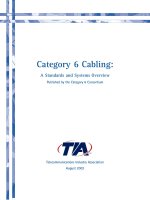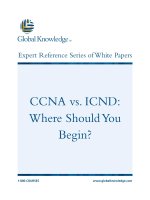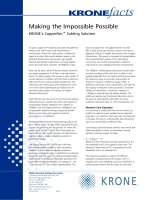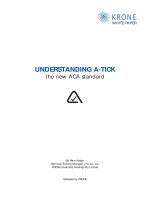White Papers_Chapin_CCNAvsICND_vGK
Bạn đang xem bản rút gọn của tài liệu. Xem và tải ngay bản đầy đủ của tài liệu tại đây (296.5 KB, 13 trang )
CCNA vs. ICND:
Where Should You
Begin?
1-800-COURSES
www.globalknowledge.com
Expert Reference Series of White Papers
Introduction
This document is intended to help students determine whether or not they are ready to take our
CCNA Boot
Camp
. Whether they are ready to start the CCNA curriculum or need a basic network fundamentals foundation
first, this white paper can help them determine which path is right and how to begin each. Since students
have varying degrees of knowledge, this paper is only intended as a “knowledge check” as to what additional
training may be needed in order to attend our
ICND1
,
ICND2
, or
CCNA Boot Camp
. This document is not
intended to be used as a final judgment of the student’
s abilities or knowledge, but rather it is an overview of
how a student can determine and develop his or her right path to success.
This paper is divided into three sections
. The first section,
Types of
Assessments
, shows you the different
tests available to help you determine into which level of CCNA aptitude you fall. The next two sections address
the two types of levels students fall into:
entry-level and CCNA-level. These last two sections:
1. Set the expectations of student knowledge for the course or courses taken
2. Discuss types of students
, needs, and experience levels (qualifying the experience level and matching
to either the
CCNA Boot Camp
or
ICND1
and
ICND2
3. Explain the
CCNA Boot Camp
pre-work, post-work, and extended hours
4. Discuss the
CCNA Boot Camp
pre-assessment test and how to access the test
5. Discuss the standard Global Knowledge Pre-Assessment
Test
6. Explain the value of using a blended-learning approach, combining Virtual Classroom E-Learning
(VCeL ), Self-Paced e-Learning (SPeL), and instructor-led classroom formats
7. Provide recommendations when students feels that their networking experience or knowledge is not
adequate enough for the
CCNA Boot Camp
or ICND courses
.
8. Next steps students can take after completing the ICND courses or
CCNA Boot Camp
Types of Assessments
There are many types of assessments students can use to determine into which level of student they fall. The
following are some of the assessment tools Global Knowledge employs
.
Self-Assessment Questions
T
hese types of questions are useful at the start of the assessment procedure and should not be used as a final
judgment of anyone’s abilities. They help a potential student begin thinking about what he or she understands
about networking and how much additional knowledge is needed before beginning training. The following is a
list of self-assessment questions we recommend asking. Answers can be found at the end of this white paper.
Rick Chapin, Global Knowledge Instructor
CCNA vs. ICND:
Where Should You Begin?
Copyright ©2008 Global Knowledge T
raining LLC. All rights reserved.
Page 2
1
. What is an IP Packet used for?
2. What does an ICMP provide?
3. ARPs provide which type of information?
4. How many classes are there for IPv4 addresses?
5. Why do we need Subnetting?
6. What does a Subnet Mask do?
7. What is the difference between Static and Dynamic Routing?
8. For what is a WAN connection needed?
9. What is the difference between User and Privilege modes on a Router?
10. The configuration file is stored in which location on the Switch?
If you do not know the answers to the questions above or do not understand what is being asked, a basic net-
working class would be your next appropriate step.
Global Knowledge – Mentoring Assessment Testing System (MATS)
Global Knowledge provides online assessment tests to help determine your knowledge level. The following
address will link to those assessments:
http://db
.globalknowledge
.com/test/setDir.asp
Tests Available on the Global Knowledge Web Site
The tests listed in the following chart are also available to help assess the starting point for a student’s train-
ing and/or certification path.
Copyright ©2008 Global Knowledge T
raining LLC. All rights reserved.
Page 3
Test Name
Length
(minutes)
Number of
Questions
Networking – Network Management
15 10
Cisco – CCNA Boot Camp Skills Check
60 20
Microsoft – IT Skills
60 20
Management Pre-Assessment Quiz
60 26
Business Analysis Quiz
60 20
Networking – Understanding Networking Fundamentals Pre-Assessment Test
60 30
Networking – TCP/IP Networking Pre-Assessment Test
60 20
Wireless Networking I: Integration and Troubleshooting Pre-Assessment Test
30 15
Telephony –
T
elecommunications Fundamentals Pre-Assessment
T
est
60 20
Cisco – CCNA Boot Camp Skills Check
This test consists of 20 questions that provide basic knowledge checks. Someone passing this test should be
able to complete our
CCNA Boot Camp
. It’s also important for the student to evaluate whether he or she is
ready to attend a course that is 10 – 12 hours long and taught in a fast-paced environment with minimal time
for lab work. If a student fails this test, he or she should take the
Networking – Understanding
Networking Fundamentals Pre-Assessment Test
and/or the Networking – TCP/IP Networking
Pre-assessment Test
.
Networking – Understanding Networking Fundamentals
This test consists of 30 questions that provide basic networking knowledge checks. Someone passing this test
should be able to handle
Interconnecting Cisco Network Devices 1
(
ICND1
) or our
Cisco Certified Entry
Network Technician eCamp
(
CCENT eCamp
). Potential students should determine whether or not they want to
review the basic Cisco material (CCENT) or go directly to
ICND 1
. If a student does not pass this test, he or she
should attend our
Understanding Networking Fundamentals
course and reading through some of our related
white papers posted at
www
.globalknowledge.com/knowledgecenter
.
Networking – TCP/IP Networking
This test consists of 20 questions that test TCP/IP networking knowledge. Someone passing this test should
be able to complete
ICND1
and/or
ICND2
. Students should determine their knowledge level of configuring
Cisco Router and Switch devices before going to
ICND2
. But most of the information needed is in
ICND1
. If a
student fails this test,
he or she should considering taking either our
TCP/IP Networking
course
, our
CCENT
eCamp
, purchasing a TCP/IP reference book, and/or reading through some of our related white papers.
25 Test Questions
These CCNA-level questions help assess whether or not you have a higher level of networking knowledge. They
are considered CCNA-level questions. Answers to these questions can be found at the end of this white paper.
1. Determination of best path is the function of which OSI layer?
a.
Physical
b. Datalink
c. Application
d. Network
e
. Transport
2. Which of the following are benefits of the layered OSI model? (choose 3)
a. Simplifies learning
b. Helps programmers write more efficient applications
c.
Requires new technologies to create updates for each layer
d. Reduces complexity by breaking network communications into smaller simpler parts
e. Facilitates modular engineering, which helps to accelerate updates and improvements while
continuing to provide interoperability
Copyright ©2008 Global Knowledge T
raining LLC. All rights reserved.
Page 4
3. Which of the following are characteristics of IP? (choose 2)
a. Connection-oriented connectivity
b. One-way datagram service
c. Best effort delivery
d. Windowing
e. Flow control
4. Which of the following are not characteristics of TCP? (choose 2)
a. Session multiplexing
b. Flow control
c. Datagram service
d. Connection oriented
e. Unreliable
5. In order for successful transmission at Layer 2, communication must take place:
a. In different subnets
b. In the same collision domain
c. In the same broadcast domain
d. In the same autonomous system
e. Through a router
6. Which of the following statements best describes the ARP cache for IP communications?
a. Only Routers and L3 Switches maintain ARP Caches
b. Only L2 Switches maintain ARP cache
c. Only Routers maintain
ARP caches
d. All Routers, Servers, and Clients maintain
ARP Caches
e. ARP cache is a function of all Layer 2 devices, including switches and bridges
7. The 802.2 protocol defines:
a. The IEEE standard for Ethernet
b. The IEEE standard for Token Ring
c. A standard that tells the DataLink layer what to do when it receives a frame
d.
A star or bus topology at the Datalink layer
e. The original Ethernet Frame Format
8. Crossover cables are required when connecting: (choose 3)
a. Router to a Switch
b
.
PC to a Switch
c.
Switch to Switch
d. Router to Router
e. PC to Router
9. An excessive number of late collisions is an indication of:
a.
A bad port
b. Port security violation
c. Excessive broadcasts
d. Duplex mismatch
e. Wrong VLAN
Copyright ©2008 Global Knowledge T
raining LLC. All rights reserved.
Page 5









